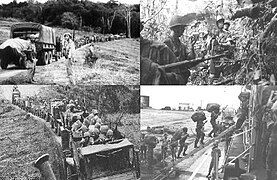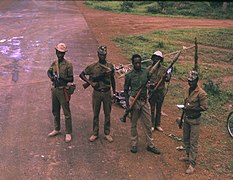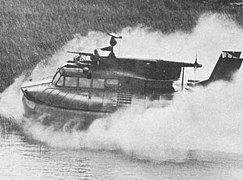Operation Kipling
This article is a work-in-progress because it is incomplete and pending further input from an author. Note: The contents of this article are not considered canonical and may be inaccurate. Please comment on this article's talk page to share your input, comments and questions. |
| Operation Kipling | ||||||||||
|---|---|---|---|---|---|---|---|---|---|---|
 First row: troops in a "bush brief" in Pursat 1971, Troopers on patrol in Kandara 1967 Second row: a Bulkhi politicians car burns after it was ambushed in 1969, Daxian jet preparing to bomb Tanhai 1971 Third row: Burgoignesc legionnaire parachutists board a plane to be dropped into Kandara 1975, Burgoignesc Legion armored cars refueling in Umardwal 1976. | ||||||||||
| ||||||||||
| Belligerents | ||||||||||
|
Liberty Coalition | Kandaran Communist Guerillas | Battganuuri/Umardi Communist Insurgency | Bulkawan People's Republic | Pursatni Communist Party and Army | ||||||
| Audonian ComIntern | ||||||||||
Operation Kipling was a series of wars fought by a coalition of nations led by Burgundie, Urcea, Alstin, and Tierrador against the Audonian ComIntern and various communist militias in Daria from 1966-1983. It diminished Burgundie's roles as a major player in global politics for the remainder of the 20th century, resulting in a societal shift that led to the end of a royal dynasty, but reinvested Burgundie in the destiny of western Audonia. It also, through war industry, launched some Middle seas region nations, firmly into the 20th century.
Background
Communism in Audonia goes back as far as in 1906 when Battganuuri philosopher Kass Gazisishir.
1962 Communist Coup in Kandara
Combatants
Audonian ComIntern
Liberty Coalition
- Burgundie
- Urcea
- Alstin
- Tierrador
- Kandara
- Umardwal
- Battganuur
- Bulkh
- Pursat
- Peshabiwar, to keep the Umardi communists from spilling into Pesh
- Thervala
Tierradorian involvement
Tierrador had seen slightly limited outreach in global politics in the mid-20th century due to the governance of the oligarchic Walakee State. It was not aligned with either Caphiria or Urcea during the Occidental Cold War, instead taking a strict third-party stance during the conflict and focusing mainly on expanding its sphere of influence to the rest of South Crona, in order to compete with growing influence from Alstin and Arcerion. Despite the state’s distancing from Levantine policy, it still maintained decent relations with Burgundie, more specifically in the Burgoignesc colonies in Audonia, through foreign work programs. Tierrador stayed neutral through the first five years, due to most of its military resources being directed towards Istrenya in the Mosquito War.
In 1971, Umardi communist rebels in Asrabad captured a hotel and held the occupants, at the time made up of Qabóri contractors, hostage for over 5 months. The rebels had originally intended to dissuade the Tierradorian government from intervening in the conflict. Despite that, it only added to the many list of pressure points that the Walakee oligarchs had on Pedro Kintón. In early 1972, Kintón authorized the initial deployment of 6,000 TDF personnel to Umardwal under the newly-established TDF Umardwal/Tapakdore Command, freeing the hostages and eventually joining the war on the side of the coalition. Domestically, involvement in Operation Kipling added on to the anti-war movements within South Crona, which led to tighter restrictions on political dissent throughout the country. Kintón was not able to invoke the South Cronan Mutual Defense Treaty, which would have brought Ceylonia and Porlos into the war, as it was technically not a defensive stance by Tierrador.
By 1977, 16,000 TDF personnel had been deployed in Umardwal, Kandara, and Battganuur. TDF deployment in Operation Kipling had reached its peak in 1980, at 22,000 total troops. Tierrador was eventually forced to reduce a sizable number of troops in 1981 after an invasion on the Tierradorian homeland by Asteria, which sparked the Cowboy Crisis. In 1982, Tierradorian deployments reduced to 9,000 troops, and 5,000 in early 1983.
Ther involvement

Due to Thervala's close relationship with Burgundie and the developing insurgency in the provinces, Marshall Kittisak proactively sought out involvement in Operation Kipling as well as the Liberty Coalition. The wartime government of Marshall Kittsak signed into multiple agreements with the member states of the liberty coalition that promoted freedom of military movement throughout Thervala and the freedom to build and maintain bases within the Kingdom. The Kittisak regime had also pledged the entire Royal Ther Military into helping against the communist insurgencies all across Audonia.
At the time, it was thought that some founding officers of the Red Army of Thervala might be associating with and advising communist paramilitaries in Eastern Audonia, as it was not yet public knowledge that a majority of them were in Geisenroda. As such, Royal Ther Marines were typically tasked in special operations against insurgent operations centers. Only one RAT officer was found in Operation Kipling, former Ther soldier Thanakorn Suthisarn. He worked in an advising role for communist insurgents in Kandara and helped train them in small unit tactics as well as urban warfare. Suthisarn was apprehended by Royal Ther Marines in 1974, he was then flown back to Wat Khram and executed on live television. This is considered to be a defining moment in the Kittisak regime.
Ther presence in Operation Kipling, was, for the first few years, welcomed. The Ther military worked well with other members of the coalition and played a vital role in peacekeeping during Kipling's early years. However, as time went on, the Ther military became infamous for its cold and inhumane methods of counter-insurgency. Long term involvement in the war and consistent attacks on Ther personnel by communist insurgents lead to distrust between occupational Ther forces and the local populations. Most notably, units within the Royal Ther Marine Corps have engaged in at least 13 recorded instances of anti-communist mass killings. The most famous of which was the Rampur Massacre, where RTMC division 'Heavenly King Cobras' rounded up an entire village of men, women, and children and killed them all. The Kittisak regime's official position on the matter was that Rampur village was a hot spot for insurgent activity and potentially a "Communist Insurgent Commune [sic]". A Ther photojournalist embedded with the Heavenly King Cobras discreetly photographed the process and released the photographs to the press once he was out of Audonia. News of the massacre lead to international outrage and further inflamed Thervala's domestic insurgency.
With help from the coalition forces, Thervala had systemically eradicated its communist insurgency. Despite Ther's growing economic position from the massive amounts of military traffic, Thervala's population was tired of the war and Kittisak's brutal style of ruling. On the night of April 12th, 1980, RTMC division 'King's Royal Fighting Tiger Corps' accompanied by democratic protestors stormed the capital, leading to a firefight between Kittsak's personal 'Venomous Blowfish' division. Eventually, more RTMC divisions came to support the Royal Fighting Tiger corps. The capital was stormed and Kittisak was killed. The democratic faction within the Ther military reinstated King Ananda Varma I as the head of state. King Varma I formally withdrew the Ther military out of Operation Kipling, ending Thervala's almost 20 year involvement. Varma I also severely limited foreign military presence within the country, except for the military forces of Burgundie.
Gallery
-
Burgoignesc soldiers on patrol in Andivaz province in Battganuur, 1968.
-
Burgoignesc PACV on patrol
-
Burgoignesc Hurricane Aircat airboat on patrol
-
Burgoignesc Hurricane Aircat airboat squad on patrol












